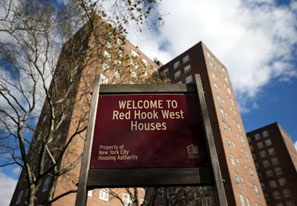
Americans think of public housing as a permanent backwater of poverty—and justifiably so. Half of households living in public housing earn less than $10,000 a year, and only 4 percent comprise two-parent families with children. In the Department of Housing and Urban Development’s so-called Housing Choice Voucher program—which subsidizes rents in private apartments—the situation is similar. Almost half of tenants earn less than $10,000 a year, and single parents rent some 900,000 units. After 1996, when welfare reform went into effect, recipients of cash public assistance faced time limits on eligibility; public-housing residents, by contrast, can remain in their dwellings indefinitely. The median “tenure” for both public-housing developments and voucher units is more than nine years; in New York City, the nation’s largest public-housing system, it is 17 years.
Public housing, in other words, is the face of long-term American poverty—including its racial dimension. Forty-eight percent of public-housing households are black, nearly four times the percentage of blacks in the U.S. population. Attempts at reform over the last two decades have focused too much on such apparent problems as architecture, in the belief that high-rise buildings were the core problem, rather than the inefficiencies of government management and policies that fostered poverty—especially a rent system that requires tenants who earn more to pay more, thus discouraging work.
A proposal included in a just-passed Senate appropriations subcommittee bill marks a promising departure. The proposal would expand the well-named Moving to Work (MTW) program from 34 of the nation’s 3,100 local public-housing authorities to 300. Originally enacted in 1996, the same year that welfare reform was passed, MTW gives housing authorities broad discretion to use federal aid; for instance, if they save money on administration, they can use it to fund repairs. But the program also lets the authorities adopt measures that could dramatically change the culture of public housing. These include work requirements, time limits for new tenants (or those who agree to them as part of “self-sufficiency” programs), and rent rules that let tenants keep more of what they earn as they prepare for post-project life.
If a next wave of MTW resembles the first one, change could be widespread. A 2014 report by Abt Associates found that 20 of the 34 MTW authorities have changed their rent rules to encourage “self-sufficiency,” 11 have adopted work requirements, 11 have imposed mandatory obligations such as participating in work-readiness programs, and eight have adopted time limits for tenants in the service of upward mobility. Consider the language of the San Bernardino, California, housing authority, in explaining why new housing-voucher holders face a time limit: “The goal of the activity is to enable the families we serve to focus on self-sufficiency efforts while we assist them with their housing needs for a limited term.” Incomes among time-limited tenants have risen by more than 12 percent, and employment has spiked by 17 percent. The time limits also make units available for those who’d otherwise be stuck on a waiting list.
The Atlanta Housing Authority uses even stronger language to explain its work requirement for the nondisabled: “AHA continues to believe strongly in the value, dignity, and economic independence that work provides.” In some Atlanta developments, employment rates (or enrollment in education or training) run as high as 94 percent. The Abt report also found that 20 of 34 MTW authorities are moving to change rent rules that require tenants to pay 30 percent of their incomes in rent—implying a rent increase of 30 cents for every additional dollar earned and providing an unintended incentive to move to the underground or even criminal economy.
These changes—call them conservative antipoverty policies—would finally let housing authorities run their systems in ways that would actually help the poorest improve their circumstances. Spreading an MTW approach to hundreds of authorities would align housing policy with the time-limited cash-welfare policy that has reduced public-assistance rolls. More broadly, it would constitute a historic acknowledgment that public housing today has little in common with the Depression-era theory that spawned it—the belief that the private-housing market would inevitably fail all but the wealthy. As reality debunked that idea, public housing became a backwater of long-term poverty.
Expansion of the Moving to Work approach is far from inevitable, and the Senate proposal may not see the light of day. Budget politics could intervene; Congress may opt to fund the government through a continuing resolution rather than with new appropriations bills. And the proposal, pushed by Republican senator Susan Collins of Maine, limits MTW to housing authorities with fewer than 22,000 units. New York’s system—with 175,000 apartments and 91,000 rent-voucher recipients—would not be included. Still, the idea enjoys bipartisan support. In the House, the proposal has the backing of Democrat John Carney of Delaware, where the state housing authority has adopted an MTW time limit. Those concerned about ameliorating rather than accommodating long-term poverty should hope that the nation’s public-housing systems, long a locus of dysfunction, might yet become a beacon of hope.
